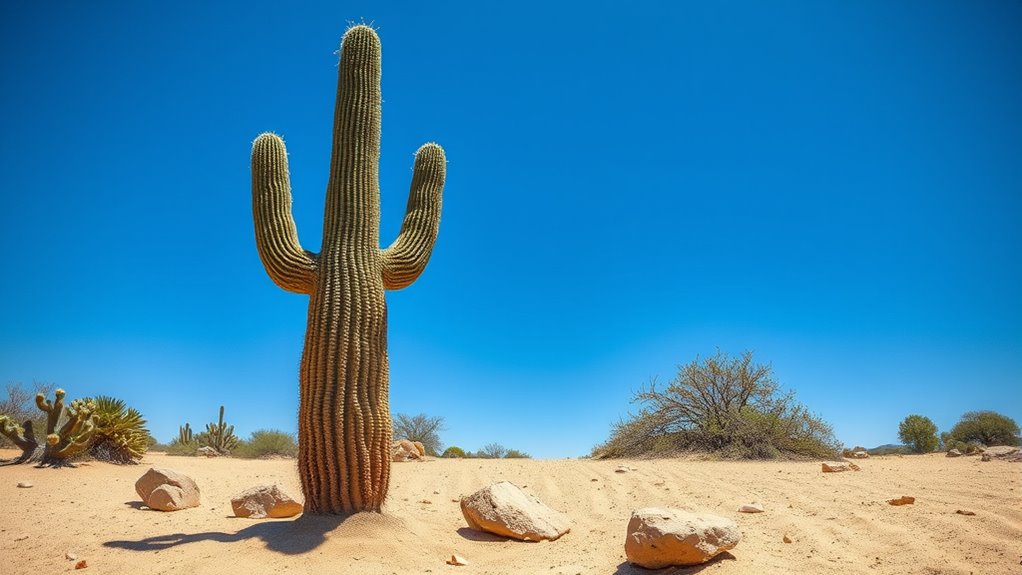In deserts, animals and plants use special adaptations to survive and thrive. Nocturnal behavior helps them avoid daytime heat and reduce water loss. Many have physical traits like thick shells, scales, or waxy coatings to conserve moisture. Some, like kangaroo rats, extract water from their food and produce highly concentrated urine. Plants store water in fleshy tissues or develop deep roots to access underground sources. Keep exploring to uncover more extraordinary ways life endures in harsh desert environments.
Key Takeaways
- Many desert animals are nocturnal, active at night to avoid daytime heat and reduce water loss.
- Water conservation adaptations include highly efficient kidneys, moisture extraction from food, and water storage in body parts.
- Physical traits like thick fur, scales, and shells help desert animals minimize water loss and withstand temperature extremes.
- Plants adapt with small, thick leaves, wax coatings, deep roots, and CAM photosynthesis to conserve water.
- Overall, desert species rely on behavioral, physiological, and structural strategies to survive and thrive in arid environments.

Deserts are some of the harshest environments on Earth, where extreme heat, scarce water, and limited food sources challenge both plants and animals to survive. If you find yourself exploring these arid landscapes, you’ll notice that many creatures have developed unique survival strategies. One of the most common adaptations is nocturnal behavior. By being active at night, animals avoid the blistering daytime heat, reducing water loss and energy expenditure. You might see desert foxes, rodents, or insects scurrying around after sunset, taking advantage of cooler temperatures. This behavior helps them conserve water since evaporation rates are considerably lower during the night. Additionally, nocturnal activity limits exposure to the sun’s harsh rays, decreasing the risk of overheating and dehydration. Many animals also have specialized sensory organs that help them detect prey and predators in low-light conditions, further enhancing their survival chances.
Water conservation becomes absolutely critical in these environments, and animals have evolved remarkable methods to minimize water loss. Some creatures, like the kangaroo rat, have adapted to survive without drinking water at all. Instead, they extract moisture from the seeds they eat, and their kidneys are highly efficient, producing concentrated urine to conserve water. You’ll also observe animals with specialized features, such as the desert tortoise, which can store water in their bladder for periods of scarcity. Many desert animals have tough, insulating outer layers—like thick fur, scales, or shells—that help reduce water loss and protect against extreme temperatures. Some insects and reptiles have the ability to slow their metabolic rates or enter states of dormancy during the hottest parts of the day, further conserving precious water and energy. Adaptations like these are essential for survival in such extreme environments. Interestingly, many of these adaptations are driven by water conservation techniques, making them vital for enduring the relentless desert conditions. Moreover, some plants have developed drought-resistant features that enable them to survive extended dry periods without water.
Plants, too, have adapted their water conservation tactics. You’ll notice that many desert flora have small, thick leaves or spines instead of large, flat ones, which reduces surface area and water loss. Succulents, like cacti, store water in their fleshy tissues, allowing them to survive long periods of drought. Their waxy coatings reflect sunlight and prevent dehydration. These plants often open their stomata—tiny pores on their surfaces—at night rather than during the day, a process called CAM (Crassulacean Acid Metabolism) photosynthesis, which helps conserve water while still performing photosynthesis. This adaptation allows them to thrive despite the extreme conditions. Moreover, some desert plants have deep root systems that reach underground water sources, ensuring access to moisture even during prolonged dry spells.
Understanding these adaptations gives you insight into how life persists in some of the planet’s most unforgiving environments. Whether through nocturnal behavior, specialized water conservation methods, or unique physical features, desert creatures have mastered survival strategies that enable them to thrive amid the relentless heat and dryness.
Frequently Asked Questions
How Do Desert Animals Stay Hydrated During Droughts?
During droughts, you might wonder how desert animals stay hydrated. They rely on water conservation and physiological adaptations, such as minimizing water loss through their skin and breathing. Some animals, like camels, store fat in their humps which converts to water. Others get moisture from their food or produce it internally via metabolic processes. These strategies help them survive extreme conditions and conserve every drop of water.
What Plants Can Survive Extreme Desert Temperatures?
You’ll find that certain plants, like succulents, survive extreme desert temperatures thanks to specialized adaptations. Their succulent adaptations allow them to store water in thick, fleshy tissues, helping them endure droughts. Additionally, their root systems are often extensive or deep, enabling them to access underground moisture. These features work together, so you can see how these plants thrive even when the heat is intense and water is scarce.
How Do Nocturnal Animals Avoid Daytime Heat?
You might wonder how nocturnal animals avoid the intense daytime heat. They use nocturnal predator strategies, becoming active at night when temperatures are cooler. Their heat reflection mechanisms, like light-colored fur or scales, help bounce sunlight away, keeping them cooler. By resting during the day and hunting at night, these animals efficiently dodge the scorching heat, ensuring their survival in harsh desert conditions.
What Role Do Desert Microorganisms Play in the Ecosystem?
You might not realize it, but desert microorganisms play a essential role in microbial nutrient cycling, maintaining soil fertility, and supporting plant growth. They form desert microbial symbiosis, helping plants fix nitrogen and withstand harsh conditions. These tiny organisms sustain the desert ecosystem by breaking down organic matter and recycling nutrients, ensuring life persists in extreme environments. Their resilience and cooperation keep the desert alive, thriving against all odds.
How Do Humans Adapt to Desert Living Conditions?
When adapting to desert living conditions, you rely on desert clothing like loose, breathable fabrics to stay cool and protect your skin from the sun. You also use cultural survival strategies, such as seeking shade during peak heat and conserving water. These methods help you survive and thrive, enabling you to cope with extreme temperatures and scarce resources in the desert environment effectively.
Conclusion
Just like a resilient traveler steering through endless dunes, you learn that survival in the desert demands adaptation and perseverance. Every plant’s deep roots and every creature’s clever tricks become your guiding stars, showing you that even in harshest conditions, life finds a way. Embrace these desert secrets as your own, and remember—just as the sun rises again each day, your strength and resilience can shine through any challenge. Keep thriving, no matter how dry the world around you.









